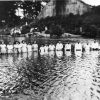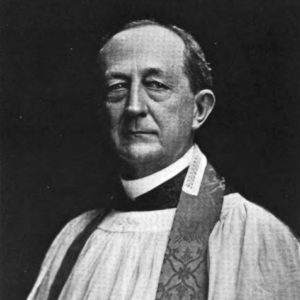calsfoundation@cals.org
James Ridout Winchester (1852–1941)
James Ridout Winchester served as the sixth bishop of the Episcopal Diocese of Arkansas from 1912 until his retirement in 1931. His episcopate faced many fiscal difficulties brought about by the overzealous plans of his predecessor William Montgomery Brown and by economic challenges resulting from World War I and the Great Depression.
James Ridout Winchester was born in Annapolis, Maryland, on March 15, 1852, to Jacob Winchester and Mary Ridout Winchester. He received a BA from the College of Washington and Lee in Lexington, Virginia, and graduated from Virginia Theological Seminary in Alexandria, Virginia. He earned four advanced degrees, including two Doctor of Divinity degrees. He married Elizabeth Atkinson Lee in Clarke, Virginia, on April 17, 1878.
Francis McNeece Whittle, Bishop Coadjutor of Virginia, ordained Winchester to the diaconate in 1877 and to the priesthood in 1878. Winchester served as assistant priest at St. James’ Church in Richmond, Virginia, and was the rector of parishes in the dioceses of Alabama, Virginia, Georgia, and Tennessee. He was rector of Calvary Church in Memphis, Tennessee, when he was elected Bishop Coadjutor of the Diocese of Arkansas in 1911. As coadjutor, his role was to assist Bishop Brown, and he would automatically become the bishop of Arkansas when Brown resigned.
Winchester was consecrated the first bishop coadjutor of Arkansas in September 1911. His consecration was the first held in Trinity Episcopal Cathedral in Little Rock (Pulaski County) and the first in Arkansas. His term as coadjutor lasted for less than one year. On April 24, 1912, the coadjutor received notification from the presiding bishop of the official acceptance by the House of Bishops of the resignation of William Montgomery Brown and the transfer of complete authority to him as the sixth Bishop of Arkansas.
The situation he inherited in 1912 was described by Margaret Simms McDonald in her book White Already to Harvest as “a sardonic and cruel fate which drew the saintly Bishop Winchester into the vortex of deflation and liquidation in Arkansas.” Under Brown’s idea that “an empty hive is an opportunity to collect a swarm of bees,” a number of properties had been purchased for congregational development where no viable congregations existed. In 1913, Winchester reported that much of the mission property was in deplorable condition and should be disposed of. In addition, under Brown, a bishop’s residence with twenty-two rooms was purchased without adequate funds for upkeep. Winchester asked the diocesan Standing Committee to investigate selling the residence, but the group wanted its bishop to keep up a certain lifestyle and said selling the home would make it appear that the Episcopal Church could not meet its debts. Winchester received a small raise to help with maintenance. The residence was not sold until 1921, following the Standing Committee’s approval for the purchase of a smaller residence.
In spite of limited funds, Winchester successfully generated operating expenses for two mission schools in northwestern Arkansas: the Helen Dunlap School for Mountain Girls in Winslow (Washington County) and the Winchester School for Mountain Boys in Havana (Yell County). The Reverend Edward Thomas Mabley served as warden of the girls’ school and helped with another of Bishop Brown’s items of unfinished business. Mabley filled the void of the defunct Arkansas School of Theology by conducting ten-day retreats for deacons and candidates for Holy Orders so they could complete their studies.
In 1917, the Diocese of Arkansas began electing assistant bishops known as suffragan bishops. That year, two bishop suffragans were elected in Arkansas. Diocesan convention delegates elected the Reverend Edwin Warren Saphore to be the first suffragan for white Episcopalians and assistant to Bishop Winchester. Saphore served until Winchester retired in 1931, and he functioned without a bishop until he was elected Arkansas bishop in his own right in 1935.
The other bishop suffragan elected that year served African-American Episcopalians. Another remnant of Bishop Brown’s episcopate was his division of the diocese according to race. Brown’s “Arkansas Plan” divided white and black Episcopalians into two separate bodies. Archdeacon Daniel E. Johnson served as the missioner to the African-American congregants and helped develop new parishes. After the Reverend James Russell of Virginia declined his election to become the first black suffragan bishop of Arkansas and Province Seven, a second convention elected the Reverend Edward Thomas Demby, Archdeacon for Colored Work in Tennessee, to be the first elected black suffragan bishop in the United States. Despite inadequate funds and many difficulties, Bishop Demby served with dedication from 1918 until 1939. Demby and a priest he selected, the Reverend James Henry King, established Christ Church Parochial School for black students in Forrest City (St. Francis County) in 1924. This school operated until 1968.
World War I caused hardships for the diocese in loss of clergy and operating support, but some innovations in communications helped to bring worship and information to isolated Arkansas Episcopalians. At Winchester’s urging in 1923, the diocese began to publish a monthly statewide newsletter, the Arkansas Churchman. In 1924, Hot Springs (Garland County) radio station KTHS began broadcasting the services of St. Luke’s Church on the third Sunday of each month, beginning with the Christmas service. Bishop Winchester supported the establishment of the Young People’s Service League (YPSL), which gave youth of the diocese opportunities to perform volunteer work.
The diocese had around 4,000 members when Winchester retired in 1931. He lived in Chicago, Illinois, until his death on October 27, 1941. Winchester and his wife are buried at Old Chapel Cemetery in Millwood, Virginia.
For additional information:
Beary, Michael J. Black Bishop: Edward T. Demby and the Struggle for Racial Equality in the Episcopal Church. Urbana: University of Illinois Press, 2001.
McDonald, Margaret. White Already to Harvest: The Episcopal Church in Arkansas, 1838–1971. Sewanee, TN: University Press of Sewanee, 1975.
Mary Janet “Bean” Murray
Little Rock, Arkansas
 Early Twentieth Century, 1901 through 1940
Early Twentieth Century, 1901 through 1940 Religion
Religion Trinity Episcopal Cathedral
Trinity Episcopal Cathedral James Ridout Winchester
James Ridout Winchester 




Comments
No comments on this entry yet.